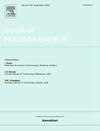A comparative study on the neutronic characteristics of the new four-petal and three-petal helix fuel assemblies
IF 2.3
3区 工程技术
Q1 NUCLEAR SCIENCE & TECHNOLOGY
引用次数: 0
Abstract
Petal-shaped helix fuel (PHF) enhances the reactor power and economic efficiency owing to its large heat transfer area, improved flow and heat transfer, and self-supporting structure. In this study, the neutronics characteristics of four petal-shaped fuel rods (FPF) and three petal-shaped fuel rods (TPF) are compared by analyzing the concave-convex ratio(also called the geometric factor for PHF, R/r), water-uranium ratio, and helix angle of the fuel rod. The results show that the difference in R/r values lead to different k∞ for FPF-FA and TPF-FA, and the k∞ of TPF-FA performs more excellently. For example, When R/r is equal to 2, the k∞ of TPF-FA is 1.13650, while that of FPF-FA is 1.12451. When the water-uranium ratio decreases from 2.3 to 1.5, the effective full power days of the FPF assembly increases from 420 to 750, and those of the TPF assembly increases from 480 to 810. At a helix angle of 720°, the maximum effective full power values for the FPF and TPF assemblies are 540d and 600d days, respectively. The non-uniformity coefficients of the FPF assembly are 0.02 % ∼ 1.80 % higher than those of TPF-FA. Finally, the FPF assembly exhibits better proliferation ability. Specifically, the resonance absorption of FPF-FA is always higher than that of TPF-FA, which improves the utilization of 238U.
新型四瓣和三瓣螺旋燃料组件中子特性的比较研究
花瓣型螺旋燃料具有传热面积大、流动和换热性能好、结构自支撑等优点,提高了反应堆功率和经济性。本研究通过分析四瓣形燃料棒(FPF)和三瓣形燃料棒(TPF)的凹凸比(也称为PHF的几何因子,R/ R)、水铀比和燃料棒的螺旋角,比较了两瓣形燃料棒的中子特性。结果表明,R/ R值的差异导致FPF-FA和TPF-FA的k∞不同,TPF-FA的k∞性能更优。例如,当R/ R = 2时,TPF-FA的k∞为1.13650,而FPF-FA的k∞为1.12451。当水铀比从2.3降低到1.5时,FPF组件的有效满功率天数从420增加到750,TPF组件的有效满功率天数从480增加到810。当螺旋角为720°时,FPF和TPF组件的最大有效全功率值分别为540d和600d。FPF组件的非均匀性系数比TPF-FA高出0.02% ~ 1.80%。最后,FPF组件显示出较好的增殖能力。具体而言,FPF-FA的共振吸收始终高于TPF-FA,提高了238U的利用率。
本文章由计算机程序翻译,如有差异,请以英文原文为准。
求助全文
约1分钟内获得全文
求助全文
来源期刊

Annals of Nuclear Energy
工程技术-核科学技术
CiteScore
4.30
自引率
21.10%
发文量
632
审稿时长
7.3 months
期刊介绍:
Annals of Nuclear Energy provides an international medium for the communication of original research, ideas and developments in all areas of the field of nuclear energy science and technology. Its scope embraces nuclear fuel reserves, fuel cycles and cost, materials, processing, system and component technology (fission only), design and optimization, direct conversion of nuclear energy sources, environmental control, reactor physics, heat transfer and fluid dynamics, structural analysis, fuel management, future developments, nuclear fuel and safety, nuclear aerosol, neutron physics, computer technology (both software and hardware), risk assessment, radioactive waste disposal and reactor thermal hydraulics. Papers submitted to Annals need to demonstrate a clear link to nuclear power generation/nuclear engineering. Papers which deal with pure nuclear physics, pure health physics, imaging, or attenuation and shielding properties of concretes and various geological materials are not within the scope of the journal. Also, papers that deal with policy or economics are not within the scope of the journal.
 求助内容:
求助内容: 应助结果提醒方式:
应助结果提醒方式:


